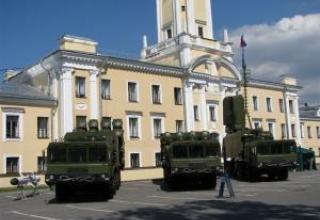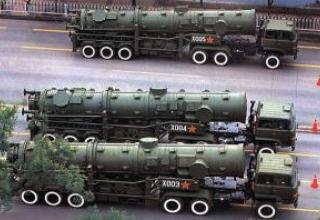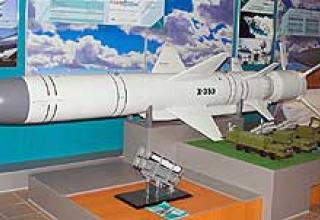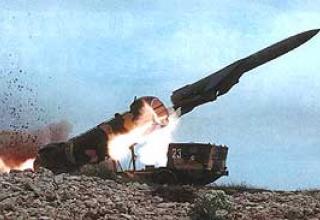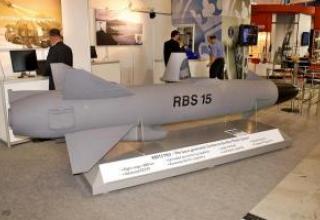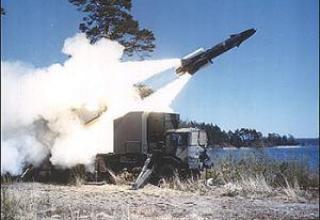The SSM-1 (Type-88) coastal anti-ship missile system was developed by Mitsubishi Heavy Industries for Japanese self-defense forces and adopted for service in 1988. The SSM-1 batteries are currently the main attack units of the Japanese Coastal Defense Forces.
The complex was tested in 1987 in Point Mugu (USA, California), according to their results the complex was highly appreciated by American specialists.
The upgraded version of the complex, designated Type 90, is equipped with a rocket with enhanced protection against electronic warfare.
These complexes play a strategic role, as they can prevent Pacific Fleet warships from breaking through the straits surrounding the Japanese Islands into the Pacific Ocean from their bases in the Far East.
Since 1994, Mitsubishi Heavy Industries has launched a program to develop (at an approximate cost of $18.6 million) a new XSSM-2 anti-ship complex with a range of up to 250 km and a vertical missile launch scheme.
Composition:
The SSM-1 missile (see photo) is based on the ASM-1 Type-80 aircraft anti-ship missile and differs from the prototype by the presence of a launch accelerator and a turbojet engine (TRD) of a marching stage. The TJM3 TRD was developed by Mitsubish and with a weight of 45 kg it develops 2000N thrust. The use of turbojet engine has provided a sharp increase in range.
Battery SSM-1 (Type-88) includes 11 vehicles:
- the missile firing control room,
- Four launchers (PU) on the chassis of a Type 74 truck with six missiles,
- Radar detection and tracking of targets,
- radio relay digital communication station,
- four recharging machines.
Radio relay communication station and radar detection are placed on Type 73 - 4 x 4 vehicles. The JTPS-PII detection radar is equipped with a JAS-PIO phased-in grating. The control post and the radio relay communication station are located in cabins without armour protection.
The PU is recharged by a recharging machine by means of a crane by replacing the starter tube pack.
Time of battery deployment from camping position to combat 45 min. Radars are usually deployed on the coast, and boosters can be located up to 50 km from the shoreline. The missiles are launched at 2-second intervals. The missile's flight over the coast up to the water's edge is carried out at low altitudes with obstacle avoidance, over the sea the altitude of the flight decreases and with the capture of the active radar target the attack is carried out at extremely low altitudes. The flight speed is 0.9M.
Four PKR SSM-1 batteries are reduced to a fire group with 55 special vehicles (44 battery cars, command and staff car, two radars and eight radio-relay communication stations). The Japanese Navy plans to have three fire groups (16 batteries) of SSM-1 with 48 PU.
Characteristics:
| Firing range, km | 150-180 |
| Starter weight, kg | 660 |
| Weight of combat unit, kg | 225 |
| The length of the rocket, mm | 4000 |
| Length of launch accelerator rocket, mm | 5100 |
| Body diameter, mm | 350 |
| Wingspan, mm | 1200 |
Testing:
Description of a typical training flight for conditional use
Due to the appearance of SRAM missiles in the service of strategic aviation units have become more complex and new functional responsibilities for pilots and navigators of the main carriers - B-52 aircraft (the crew included: the ship commander, second pilot, navigator-navigator, navigator-operator of weapon systems). Particularly large responsibility for the use of missiles lay on the navigators. The most senior one was a navigator-navigator (a higher staff category). Usually, this position was assigned to persons who had extensive flight experience in SAC or who had flown on B-52 aircraft as navigator-operator for at least 2-4 years. The navigator-operators could be graduates of flight schools who had excellent skills in various weapons management systems during their service in aviation units.
In order to master new weapons as quickly as possible, the U.S. Air Force regularly trained its bomber crews, both on simulators and during training flights with conditional launches of the AGM-69A. The apex was the annual training and combat missile launches at training ranges (one launch from each selected wing).
Preliminary preparations were made on the eve of the flight. The entire crew was working on the tasks of the upcoming flight in specially equipped classrooms and simulators. Besides, the navigators prepared route maps and necessary flight documentation.
In special classes, involving officers of the engineering and technical service, the crew's actions in preparing and launching missiles were lost. Magnetic records of programmed target coordinates and missile flight trajectories were reviewed (several trajectories can be programmed for them). The instructions and documentation on their combat application were re-examined. Navigators familiarized themselves with the order of entering into the missiles of the initial data from the aircraft central digital computer, as well as with the ground radar, necessary to accurately reach the target and prepare for operation of the missile flight control system. The crew members then specified the conditions of radio exchange and direction finding with the operators of the radar of the range. The chief officer told the crew about the nature of the targets and additional markers that could be used as outgoing aiming points.
The preflight preparation began with clarification by the crew of the data on the meteorological situation and additional instructions on the upcoming flight and the preflight inspection. Upon arrival at the bomber station, each crew member, according to his or her duties, began to inspect and check the performance of onboard equipment. The navigators paid special attention to monitoring the condition of suspended missiles and bombs, as well as the serviceability of the weapons control system. The latter included, inter alia, an inertial navigation subsystem, a navigation and bomber subsystem, a central digital computer and data conversion units. On board were three SRAM missiles (two on wing pylons and one on a revolver-type launcher) and practical air bombs. The crew members then took their seats on the aircraft and reported to the ship's commander on mission readiness.
Shortly after takeoff, the navigator-operator turned on the power supply to the weapons control system. Approximately 30 minutes later, a red light on its panel indicated that the equipment was ready for full operation. When approaching the first control point, navigators entered course values, speed, altitude and other data into the inertial navigation subsystem. After that, the red light bulb went out. During this operation, the straight horizontal flight mode was strictly maintained.
The action stage of the SRAM prelaunch preparation was called the TAL (Transfer Alignment Maneuver) rocket INN exhibition. It took 2 to 15 minutes before launch and was necessary to provide the weapon with accurate information about the launch vehicle speed. In most general terms, the maneuver was a long "snake" in the horizontal plane for several minutes. This was done so that data on the velocity and spatial position of the missile and the launch vehicle were processed by Kalman filtering, thus minimizing possible guidance errors. At the end of each "snake", the B-52 should have been held in straight flight for about a minute.
Then the navigator-navigator on the screen of the radar indicator precisely held the electronic crosshairs on the mark of the selected landmark, and the navigator-operator put the initial coordinates of the plane's location in the central digital computer. From that moment on, the computer continuously generated the current coordinates of the aircraft's position. After a while, the navigator-operator turned on the SRAM missile flight control system and corrected the inertial guidance unit based on data from the central digital computer. For SRAM, correction of the LPF (Launch Point Fix) launch point was introduced in order to finally prepare its guidance system for launch. Before reaching the launch boundary, the programmed flight path, coordinates of the Launch Point and the target and other data were entered into the digital computer of the missile. Then, during a 5-second prelaunch period, the coordinates from the launch vehicle's sighting and navigation system were entered into the missile's guidance system. Depending on terrain conditions, the strength of the enemy's air defense system, as well as on the general military situation, one or another version of the missile's flight path to the target was chosen.
The weapon control system automatically determined the moment of finding the bomber at the launch boundary (the distance that the missile must fly to hit the selected target). The weapon control panel was illuminated by a signal board "Safely, within range". At this time, the missile was automatically launched under real conditions. After the launch, the missile compared the actual flight path with the trajectory programmed, stored in the memory of the digital computer, and generated signals of misalignment, which in the form of commands were fed to the wheels of the missile.
In the conditional application of the missile crew before entering the launch boundary performed a number of additional operations. Communication with the range was established and there was confirmation that the ground radar stations accompany the aircraft. For 20 seconds before conditional launch navigator-navigator included a special transmitter, the signals of which the team of the range controlled the moment of starting the rocket or dropping the bomb. When the flight time to the launch point was 5 seconds, a flashing light bulb appeared on the weapon control system panel, which informed the crew that the missile was ready for use. The navigator-operator pressed the action button. The flashing of the light bulb stopped. The "launch" of the missile was simulated by a special sound signal. In this flight, the crew made a conditional "launch" of one missile each time they entered the target of the range. After the task was completed, the flight was analyzed.
Sources:
-
В. Малышев "Средства береговой обороны и перспективы их развития" Зарубежное военное обозрение N 3-8 2001г.
-
FAS "Japan. Executive Summary"
-
Type 88 Surface-to-Ship Missile SSM-1 (www.mhi.co.jp)
-
Type 80 ASM-1




